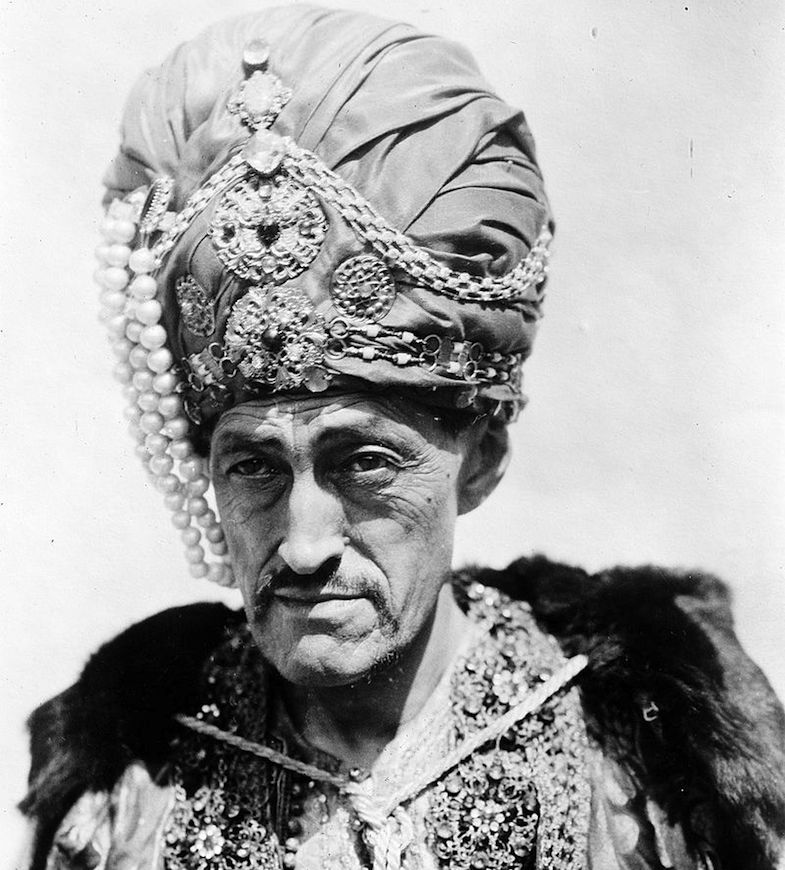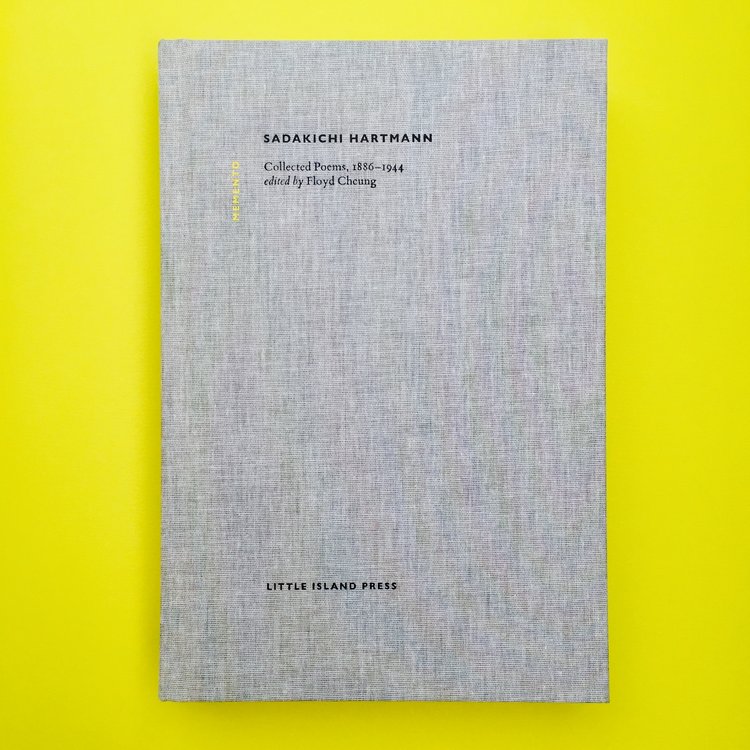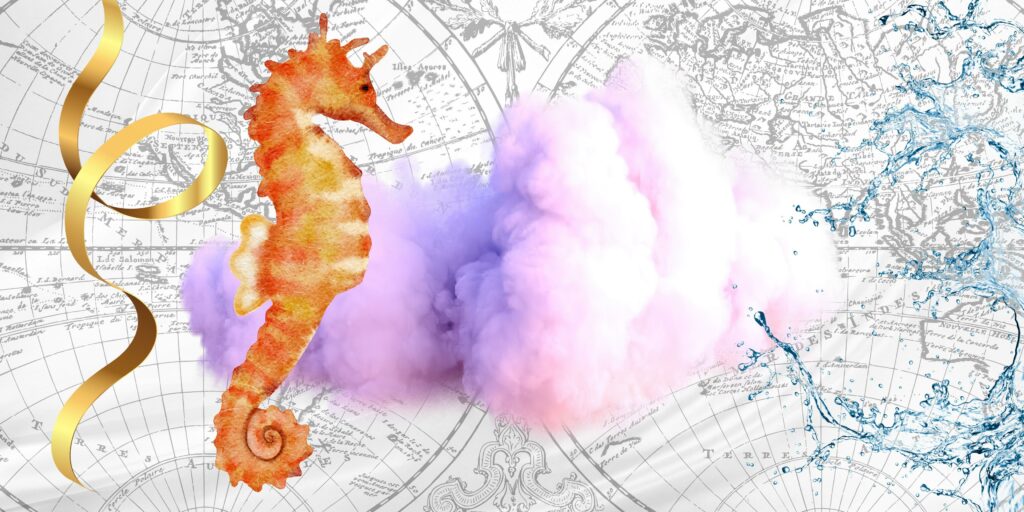How the Japanese American poet, art critic, and performer helped shape Modernist poetry as he brought Japanese poetic forms into English

April 30, 2018
“Sadakichi is singular, never plural,” declared Gertrude Stein. Indeed, there can have been only one Carl Sadakichi Hartmann (1867–1944). An innovative writer, critic, performer, and bon vivant extraordinaire, Hartmann helped to introduce Japanese poetic forms to the English literary tradition, championed photography as an art form, conducted “concerts” with smells instead of sounds, and drank riotously with everyone from the Symbolist poets of Paris to the Bohemians of Greenwich Village to the movie stars of Hollywood.
Born in 1867 on the isle of Dejima, Japan, to a Prussian merchant named Carl Herman Oskar Hartmann and a Japanese woman named Osada, the young Hartmann was sent to be raised by a rich uncle in Hamburg after his mother died a few months after his birth. Baptized a Lutheran and wrapped in luxury, Hartmann learned literature, art, and upper-class deportment during his childhood. Being forced to attend the German Imperial Naval Academy, however, did not agree with the independent-minded, teenaged Hartmann, who decamped to Paris. Displeased, his father shipped him off to another branch of his family in Philadelphia in 1882 with $3 in pocket money.
The already melancholy Hartmann keenly felt this change of scene, especially since he had to work sometimes as a lithographic stippler, perfume peddler, photographic retoucher, or spittoon cleaner. For solace, he turned to books. In Philadelphia, Hartmann read voraciously in libraries and bookstores, eventually discovering Leaves of Grass by Walt Whitman. Thoroughly taken with Whitman’s verse and searching for a mentor, the seventeen-year-old Hartmann visited the sixty-five-year-old Whitman in Camden, New Jersey, in 1884, starting what would become a deep if tumultuous relationship. In addition, via multiple cross-country trips, visits to Europe, and correspondence, Hartmann came to know many other writers, too, including Stéphane Mallarmé, Paul Verlaine, Ezra Pound, George Santayana, and of course Gertrude Stein.
In an early poem, Hartmann expressed his appreciation for Whitman: “I am bound to thee forever, thy works were to me, except Love and Nature, the grandest lessons of my life.” Although Hartmann sometimes embarrassed Whitman by telling tales out of school, inciting the latter to call the former “that damned Japanee,” Whitman still believed in him: “I have more hopes of him, more faith in him than any of the boys.”
Whitman served as a model for Hartmann’s literary career, although it was not so much that the young poet imitated the old master’s style, suggests George Knox and Harry W. Lawton, but that Whitman “influenced the literary pose which Hartmann adopted toward the world.” Specifically, they argue, Hartmann adopted “Whitman’s techniques of self-promotion, a belief in democracy despite his tendency toward seeing art as primarily for the elite, the use of press-agentry methods pioneered by Whitman, and an assertive Bohemianism traceable to Whitman.”
Hartmann’s early poems do, however, bear traces of Whitman’s stylistic influence. Hartmann was inspired by Whitman’s frequent use of natural and nautical images even if he did not couch them in free verse or anaphora. For instance, Hartmann borrows visions of waves and sails from Whitman’s “Sea-Drift” poems, and Whitman’s Leaves of Grass is echoed in the title of his Drifting Flowers of the Sea and Other Poems.
In the opening poem of Drifting Flowers, “Nocturne,” Hartmann’s speaker repeatedly conjures images of waves and sails and the melodies of “lovers’ lays,” each rising in its beautiful moment and then “lost in the dim unknown.” Seven chain-rhymed quatrains precede a sestet in which earlier phrases return before they fade away. Even the poem’s use of indentation suggests a fading away into the distance. One quatrain looks like this on the page:
Sails gleam and glimmer ghostly white,
They come and slowly drift away,
Lost in the monotone of night,
Like visions of a summer-day.
Hence, at least some of Hartmann’s early poems share Whitman’s vocabulary of images if not his confidence in perennial, grass-like return.
Although Whitman writes of the fragrance of grass, roses, and arm pits, Hartmann believed that most of his contemporaries did not pay enough attention to the sense of smell. He reminds his readers that when the character Ulysses returns to Greece disguised as a beggar, his dog recognizes him: “Undoubtedly by smell. And does not smell constitute a notable (in human beings neglected and unconscious) part of memory?” To demonstrate the potential of smell to transport an audience, Hartmann conducted a ‘Perfume Concert’ in 1902 with the aid of giant electric fans. He planned to take his audience on ‘A Trip to Japan in Sixteen Minutes’ with eight scents. Alas, a lack of technological advancement and audience patience doomed his performance, and he was booed off stage. The experimental and audacious quality of this attempt, however, attests to Hartmann’s fearlessness and imagination as an artist.
In fact, Hartmann cultivated an intense interest in art because of its ability to transport maker and audience to other worlds—inner and outer. He practiced many arts from dancing to acting to painting and, of course, writing. And at the same time, he emerged as one of his era’s great art critics. Jane Calhoun Weaver observes that “few writers were as important to the art of the United States at the end of the nineteenth century and beginning of the twentieth as Sadakichi Hartmann.”
In an essay entitled “On the Vanity of Appreciation,” Hartmann acknowledged that art critics might help a few worthy artists, but “art criticism is to me nothing but a peculiar mania for searching every expression of art, and life as well, for its most individual, perhaps innermost, essence.” Thus, pursuing art and art criticism for Hartmann was primarily a way of life—not a way of making a living, though he did have to find paying work to support himself and his family.
Fortunately Alfred Stieglitz recognized Hartmann as an especially articulate and discerning critic of photography and hired him to write for his journals, Camera Notes and Camera Work. Each issue featured reproductions of prints by leading pictorialist photographers of the day like Gertrude Käsebier, Eduard Steichen, and Steiglitz himself. Hartmann contributed essays on photography, reviews of art exhibitions, and poems to accompany these prints. In essays, he praised photographers like Steichen for having the “courage to experiment and the ambition to break with conventional laws and to create new formulae of expression.” In poems like “Dawn-Flowers,” which responds to Steichen’s work of the same name, Hartmann transports readers to “the land of shadows and dreams.”
As an art critic, Hartmann also advocated that photographers consider everyday street scenes as worthy of their attention. He admired, for instance, Stieglitz’s photograph of the Flatiron Building in New York and even wrote his own poem “To the ‘Flat Iron,’” in which he called the edifice “Rich, in showing no pretense, / Fair, in frugalness sublime.” Although Hartmann grew up in Hamburg and retired in California, he made New York the playground of his prime.

While Hartmann did not read or write Japanese, he had written in Japanese forms like the haiku, tanka, and dodoitsu, which he may have learned from Lafcadio Hearn’s book In Ghostly Japan. In 1904, Hartmann included seven tanka in Drifting Flowers of the Sea and Other Poems. Guido Bruno published a chapbook of his haiku and tanka in 1915, and in 1926, Hartmann produced a limited edition of one hundred mimeographed copies of Japanese Rhythms, which included haiku and tanka as well as three dodoitsu. He expanded this work once more in 1933.
In his editorial comments, Hartmann described tanka as a “short poem … the most popular and characteristic of the various forms of Japanese poetry. It consists of 5, 7, 5, 7, and 7 syllables – 31 in all.” Using an older spelling of haiku, Hartmann explained, “The Haikai is a Tanka minus the concluding fourteen syllables.” And finally, “The Dodoitsu is a more common and lawless form of poetical expression, limited to four lines of 7, 7, 7, and 5 syllables.” Critic Deckard Francis Hodge rightly notes that Hartmann’s tanka and haiku “reveal a playfulness in regard to boundaries, an acknowledgement of their existence, but also a willingness to traverse them.” Indeed, Hartmann served as a crucial bridge across literary boundaries, a “missing link” of American poetry—between Whitman and Pound, Japan and America, the nineteenth and the twentieth centuries.
Hartmann’s popularization of Japanese forms had a substantial impact on the development of modern American poetry. In particular, Hartmann valued concentration of image and “pictorial suggestion,” which were associated with Japanese poetics and would come to be thought of as Modernist. Other emergent poets of his day, many with whom Hartmann talked and corresponded, also valued these qualities. Poets like Ezra Pound and Amy Lowell searched for alternatives to what they considered the unnecessary ornateness and length of most Victorian poetry. Whereas Lowell modeled her work after ancient Greek and Latin examples, Pound found inspiration in Chinese and Japanese precedents. Together, they and others articulated the aesthetics of the Imagist movement. As Pound wrote in 1914, “The image is itself the speech. The image is the word beyond formulated language … The Japanese … have understood the beauty of this sort of knowing.”
How did Pound learn Japanese ways of knowing? Literary historian Ce Rosenow explains, “Pound knew Hartmann and Hartmann’s persona, which, perhaps more than his written work, contributed to Pound’s understanding of Japan.” After all, Pound did remark, “If one hadn’t been oneself, it would have been worthwhile to have been Sadakichi.”
Whether Pound read Hartmann’s poems is unknown, but as interested as he was in Japanese poetics, one imagines that he may have come across Hartmann’s 1904 essay “The Japanese Conception of Poetry” published in Reader Magazine. In this piece Hartmann describes the Japanese aesthetic of suggestiveness, which requires readers to concentrate on an image and make their own epistemological connections. Hartmann explains that a Japanese poet “simply depicts a crow sitting on a withered branch, and leaves it to the reader to complete the poetic thought.” The image itself is the speech, as Pound would say ten years later. Referring to his own poetry, Hartmann claims, “Lines like ‘turn phantoms with the colder morn’ and ‘in a hilltown among roses’ are as concentrated as any image that can be found in a tanka.” Perhaps, then, Hartmann’s prose as well as his poetry helped to introduce Japanese poetic principles to English-language writers.
It was Hartmann who explained that haiku ought to create “a unison of the external beauties of nature and the subtleties of the human soul, which has its origin in tradition and a continual association with flowers, with animals, trees, mountains and the everchanging elements.” And the brevity of the form itself mirrors the concept of mono no aware, a recognition of beauty in its transience. Consider for example the following haiku by Hartmann:
Oh, red maple leaves,
There seem more of you these eves
Than ever grew on trees!
The “red maple leaves” signal autumn, the word “eves” cuts the poem, and Hartmann’s innovative addition of rhyme reinforces the unity of the first two lines. The word “seem” incorporates human subjectivity. At this late point in autumn, the speaker suddenly realizes a difference between leaves on a tree and leaves strewn on the ground, but the nature of that difference is left up to the reader. We need to make a leap. For instance, we might remember the fleeting beauty of the tree on the first day that all of its leaves shifted from green to red, its blazing unity, though we are now surrounded by incontrovertible signs of loss. Most English-language readers in the twenty-first century understand how to appreciate this kind of poetic experience, but it was in the early twentieth that Sadakichi Hartmann began to prepare us.
Even though it has taken us 100 years to begin to acknowledge Hartmann’s contributions as a poet, he would have considered himself a success from the start. Among possible titles for an autobiography that he never completed Hartmann included Success in Failure. He understood that “true artists” like himself were not likely to succeed in terms of fortune or fame: “The true artist … has ever preferred to worship his lofty and often narrow ideals in poverty and obscurity, rather than to waste his genius on the vain world, which has but little in common with his dreams and aspirations.”
In particular, he perceived the general audience’s limited taste for poetry: “With current devaluations, poetry is not on par anywhere. When only material progress is at stake, poetry does not function.” Hence, Hartmann self-published most of his poetry in limited manuscript editions not to make a profit but to share his art with only a few readers. At the end of his life, which he spent in a shack he built near his daughter Wistaria Linton, on the Morongo Indian Reservation in Banning, California, Hartmann continued to create art by painting and writing, and he continued to communicate his ideas about art by lecturing and corresponding.
During his final year, Hartmann composed his own characteristically unconventional obituary, part prose and part poem. In it the speaker describes the sounds of ringing bells and ocean waves that rise in alarm and perturbation as Hartmann’s death approaches. At the end, however, these sounds cease, replaced by one more epistemological surprise. Falling flowers make an incredible racket: “Sadakichi Hartmann is gone a new scene is on / sounds like flowers drop one by one / / Bing! Bang! Bung! Bing! Bong! / Bung! Bing! Bing! Bong! Bang!”
Hartmann died in 1944 while visiting another daughter in St. Petersburg, Florida, but his poems live on, each one making its own glorious racket.

During his lifetime, Hartmann published poems in little magazines and self-published four of his own books—each several times and in different editions. Edwin Markam, the editor of the 1910 anthology The Younger Choir, included Hartmann as one of the rising poets of the early twentieth century. More recently, Hartmann’s poetry has been anthologized in David Hsin-Fu Wand’s Asian American Heritage: An Anthology of Prose and Poetry, Juliana Chang’s Quiet Fire: A Historical Anthology of Asian American Poetry, Cary Nelson’s Anthology of Modern American Poetry, Stephen Gould Axelrod et al.’s New Anthology of American Poetry, and Robert Hass’s American Poetry: The Twentieth Century. In his review of the latter, critic Allan Burns calls Hartmann one of the “missing links” of American poetry.
Thanks to recovery efforts by George Knox, Jane Calhoun Weaver, and others, Hartmann’s reputation as a bon vivant and art critic is secure. David Hsin-Fu Wand and Juliana Chang, however, deserve credit for calling attention to his poetry and naming him an “Asian American”—a term that was born long after Hartmann died. In his 1974 anthology, Wand argues that Hartmann “deserves mention as a pioneering voice in Asian American literature.” Valorizing his resistance to being interned during the Second World War, Wand maintains, “It is his ethnic consciousness, rather than his occasional poetry, that makes him contemporary in spirit and acceptable to the majority of postwar Asian American poets, who are concerned with the rediscovery of their ethnic heritage.” In Chang’s 1996 anthology, Hartmann receives pride of place. She writes, “Asian American poetry dates as far back as the 1890s, with the publication of poems by Sadakichi Hartmann, considered among the first to write Symbolist poetry in English.”
In contrast, the influential editors of the 1974 anthology Aiiieeeee! rejected Hartmann altogether. They argue the following:
The tradition of Japanese American verse as being quaint and foreign in English, established by Yone Noguchi and Sadakichi Hartman [sic], momentarily influenced American writing with the quaintness of the Orient but said nothing about Asian America, because, in fact, these writers weren’t Asian Americans but Americanized Asians.
What are we to make of this rejection? In some ways, their refusal to acknowledge Hartmann parallels their refusal to acknowledge another multiracial writer who has since become a subject of intense study: Onoto Watanna, née Winnifred Eaton. Born of an English father and Chinese mother, Eaton adopted a Japanese-sounding pseudonym to pursue a career as a writer. She even made up a Japanese signature, claimed to be born in Nagasaki, and dressed in a kimono for publicity photographs. This persona helped Eaton to sell many novels and even become a chief scenarist for a Hollywood studio. Some critics accuse her of passing as Japanese merely to appeal to the turn-of-the-century taste for Japonisme and make money. More recently, however, other critics have read greater subtlety and even subversion in her work.
What might Eaton’s literary critical history portend for Hartmann? In a poem entitled “Monologue,” Hartmann’s speaker announces, “prudence makes chameleons of us all.” But prudence alone is not the reason behind Hartmann’s plural aspects and performances. Regarding the supposed connection between one’s heritage and one’s art he wrote, “Biographical data do not interest me. What is the difference where a man is born, how old he is, where he studied, and where he was medaled? His art must speak—that is all I care for.” Certainly critics will debate the political meanings of Hartmann’s self-presentation and his choice of literary subjects and forms, but in the end his art must speak. With the first ever edition of his collected poems in English published by Little Island Press, we are in a better position to listen.
This essay has been edited and adapted from Floyd Cheung’s introduction to Sadakichi Hartmann: Collected Poems, 1886-1944 (Little Island Press, 2017).



